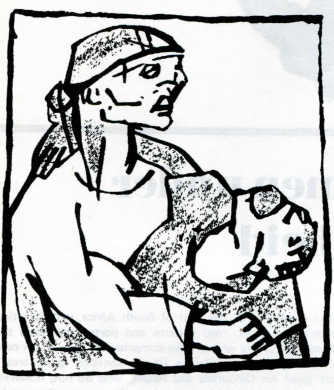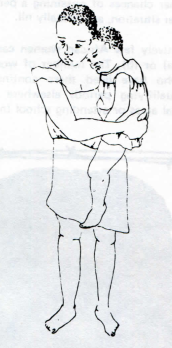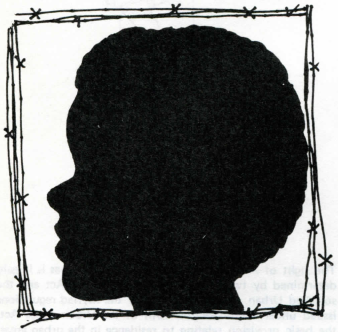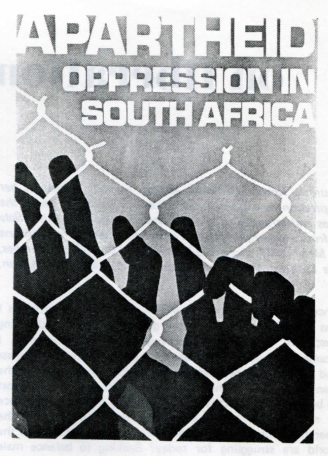
Summarized briefly and crudely, the theory of apartheid posits the existence of ten culturally distinct and mutually antagonistic "peoples" or "nations" within South Africa. All whites, lumped together regardless of mother tongue, constitute the "white nation". Africans, on the other hand, are deemed to constitute a number of different nations, determined largely by language or dialectical differences.
To provide for geographical separation and restore the traditional culture of the various nations of the Republic, the South African Government has allocated to each nation a "homeland" in which only members of that nation (as determined by descent) are citizens and all other persons are mere rightless aliens. It is official doctrine that each African nation can develop its own homeland at its own speed according to its own genius, values and ways of life.
The nine homelands provided for the black 70 percent of the South African population consist of a hodge-podge of several hundred isolated tracts of land, constituting less than 13 per cent of the Republic's land surface. They are eroded and over farmed and, even under maximum development, will be unable to support a substantial proportion of the population assigned to them.
The remaining 87 percent of South Africa, with its cities, industries, mines, road systems and ports, constitutes the homeland of the whites, who comprise less than 20 per cent of the country's population. (It also contains "group areas" set apart for Coloureds and Asians, who do not, however, have homelands.) African men from the reserves, desperately seeking work to support their families, may be admitted to the white homeland by express permission, to fill the (low paid) jobs which white workers disdain. They are deemed "transient labour units" and shipped out when they are no longer useful.
Effect on Women
The disabilities of African women in the cities arise primarily from the fact that they are viewed as the key to a possible breakdown of geographical separation. Government officials recognize the homemaking role of the women and fear that their presence in the cities will lead to the establishment of a stable black urban population. Such blacks will then, they reason, demand permanent residence — and other — rights in the white homeland where, by hypothesis, they are entitled to none.
The disabilities which particularly affect African women in the homelands ("reserves") arise out of the other phase of the theory of apartheid, namely the attempt to restore traditional African culture.
In fact, many facets of traditional African culture (e.g. the cattle culture, which requires virtually limitless grazing) cannot be restored or are inconsistent with the basic premises apartheid or interfere with white South Africa's need for a constant supply of cheap black labour for its farms, industries and mines. Moreover, the revival of certain other aspects of early African culture - e.g. animist religion - would not be tolerated by the devout "national Christian" Afrikaners. Consequently, the South African regime has created a specious version of African traditions (some verifiable, some partly correct, some spurious) which is convenient for white purposes and has foisted it on the blacks as the old-time culture by which they must abide
African Women in the Reserves
African women in the reserves suffer disabilities in virtually every facet of existence - not the least of which is that they cannot, like their menfolk, try to escape their lot by going to the cities. For nearly a decade, influx control and pass laws (discussed later in connexion with women in urban areas) have absolutely prohibited black women from entering the cities and towns.
Although African women both in the cities and in the reserves are subjected to the same disabilities, women in the reserves are particularly affected by those discussed in this section - denial of rights in land and lack of local job opportunities.
Denial of the Right to Own Land
No African may have any interest in land in the white homeland or in any homeland where he may reside if he is not a citizen.
Even in the homeland of which he is a citizen, an African is unlikely to own land. At best he will have quitrent tenure. Government policy emphasizes the continuance or restoration of communal ownership of land as one aspect of traditional culture. Under such ownership, according to South African anthropologists,Africans were granted only the right to use land, and that right was subject to enlargement, dimunition or termination, depending on relative personal or communal needs.
Since there is not enough land in any reserve to support its normal population, land allotment is a difficult and troublesome problem, exacerbated by the "resettlement"in the reserves of Africans from the cities or white farm areas. However, the difficulties have been considerably reduced by refusing, in most circumstances, to allocate land to women.
While man's allotment reverts to common age on his death, his widow is by law entitled to continue to occupy it as long as she does not remarry or leave his homestead. Thus, if she wants to try another means of supporting her family which requires her to leave home, she must forfeit her right to return to her husband's land if the alternative fails.
Lack of Local Job Opportunities
Women of the reserves, who are barred from seeking jobs in the cities where they are available, are also handicapped in seeking the few jobs which exist in the reserve. As a practical matter, some jobs are reserved for men, whether by custom, by employer fiat or by physical or other occupational requirements.
African women are frequently less mobile than their men. They cannot leave household responsibilities so casually; widows generally dare not leave their homesteads to be near a job source rather than commute, for if they do, they lose rights to cultivate family land.
Where "border industry" (in the white area adjoining a reserve) jobs are available, African women are usually hired for the lowest paid ones or are paid less than men for the same job; in some cases the cost of commuting may be too great to warrant taking up employment. In any case, border industry jobs pay far less than the same jobs in urban centres, and the hours and amenities are worse.
As a consequence, despite desperate poverty, only 13.6 per cent of all potential rural African women workers are employed at remunerative labour. Those who do work are likely to be employed as farm labourers or as domestic servants on white-owned farms near the reserves (usually while their husbands or fathers are employed on the farms) or as daily domestics, laundresses and the like in the few white cities which abut certain reserves. These are the worst paid jobs available to blacks.
Only a handful of African nurses and teachers ever manage to break out of the depressing occupational mold for rural African women. Even the few who do are usually paid rates far below their city sisters in the same jobs.
The typical "fortunate" woman in the reserves is probably the "housewife" whose husband is working in the city while she attempts to feed their children (and possibly some other dependants) on the crops she cultivates in the small eroded family plot, if any,and the meagre amounts, if any, remitted by her husband. This housewife lives out her lonely life, unable to leave, in a community composed largely of women, children and the aged and infirm who have been endorsed out of the cities once their productive years were finished.
Lest the picture of life in the reserves seem unduly harsh, it should be noted that G.F. van Froneman, a Nationalist Party spokesman on so-called Bantu Administration and Development, made the following statement before Parliament in 1968.
"If the Bantu is not doing anything here (i.e. the "white areas") he may just as well go there (i.e. the reserves) and stay there. We settle many elderly people... There are many Bantu children here who do nothing... They do not work at all. They may just as well go and stay in their homelands and do nothing."
A typical less fortunate woman in the reserves has been "resettled" there when her family - owners of a small farm in a "black spot" or labour tenants or squatters on a white farm - was evicted and forced to go to an already overcrowded reserve. There, with rare exceptions, they are not eligible tor any grazing or farm land, but may rent a tiny lot with either a one- or two-roomed hut on it or a tent, until such time as they can erect their own shelter. If the head of the family is lucky, he has permission to go back to the "white areas" to work as a transient labourer. If not, he may get a job in connexion with the resettlement centre at a rate far below urban pay for the same work, while his wife or daughters may get "make-work" at a fraction of his wages. Many resettlement centres are areas so barren and unproductive that the older inhabitants of the reserves have avoided them. In some such communities, women may spend nearly the whole day collecting firewood or carrying water from the nearest river or bore-hole, just to carry on their day to-day existence.
The lack of job opportunities in the reserves and the consequent poverty leads inevitably to sickness and death. Kwashiorkor, scurvy, pellagra and beri-beri are rife, and deaths resulting from starvation are repeatedly recorded. Tuberculosis and other diseases associated with malnutrition are widespread. The South.African Government claims that it has no mortality or morbidity figures for Africans - it does for all other South Africans - but the Progressive Party has claimed that in some reserves, one out of every two African children dies before the age of five; and special studies suggest that the infant mortality rate in certain reserves may be as high as 250:1,000. In 1960 the life expectancy of an African was estimated to be 44-46 years, while that of a white person was between 65 and 72 years. Thus in the reserves, where poverty is worst, black women who survive childbirth find that the chances of their being widowed and seeing their children die, or be frequently stunted or deficient as the result of undernourishment are greatly enhanced.
African Women in Urban Areas
African women in urban areas are subject to the same disabilities as women in the reserves. However, the forms and the effect of discrimination differ from place to place.
The right of Africans to reside in the urban areas is largely determined by two laws - the Bantu Labour Act and the so-called Urban Areas Act -and by the myriad regulations issued under them. Section 10(1) of the Urban Areas Act, the basic provision relating to residence in the urban areas, prohibits any African from remaining in an ban area more than 72 hours unless he is in possession of a permit to remain or he otherwise qualifies under the section to remain without a permit.
Three classes of Africans are qualified to remain in a specified urban area without a permit (unless they run afoul for innumerable other restrictions). They are:
(a) any African who has resided in the area continuously since birth;
(b) any African who has worked continuously in the area for one employer for at least 10 ten years or who has lived continuously in the area for at least 15 years, continues to live there, and is not employed outside the area, and who has not at any time since the commencement of the period been ' convicted of a crime (minor offences excepted);
(c) the wife, unmarried daughter or son under 18 of any African qualifying under (a) or (b) if she or he entered the area lawfully and ordinarily resides with the qualified African.
Strict enforcement of this section - even when no other restrictions are invoked - makes it far more difficult for African women than for African men to remain in an urban area.
In the first place, no African woman has been able to enter any urban area lawfully for nearly a decade, since it has become official policy not to issue permits to women. Therefore, a woman who entered illegally and has remained without incident for years will be forced to leave whenever the facts are discovered; the expiration of time does not excuse her original offence or create any prescriptive rights. This woman can never qualify under section 10(1)(c), although she may have been married for years to a qualified African; and her chances of obtaining a permit, if she tries to regularize her situation, are virtually nil.
Secondly, relatively few African women can qualify under section 10(l)(a) or (b). The number of women born in an urban area who have lived there continuously without spending disqualifying periods elsewhere - e.g., with relatives in rural areas or attending school in another area - is limited.
Finally, unmarried daughters originally qualifying under section 10(1)(c) become disqualified when they marry unless they also qualify separately under paragraph (a) or (b) or marry a qualified African man. If a husband lives in a different urban area, and they try to live together there, she will lose any qualifications she may have had under (a) or (b) without necessarily gaining a new one under (c), even if her husband is qualified. 
One of the most obvious effects of section 10(1) is, necessarily, to inhibit African women from changing jobs or protesting even the most scandalous wages, hours or working conditions and from seeking improved housing outside the area of their first residence. Another less obvious effect of the section, combined with Government policy in the larger urban areas of limiting each African township or location of members of a single "nation", is to make it increasingly difficult to marry across "national" lines or even across location boundaries.
Any African may be arrested and convicted for failure to produce his "reference book" (a plastic holder containing his identity card and all required passes, permits, tax receipts, etc.) when demanded by police officials or for failure to have all passes in order. If he is unable to pay the fine levied, he must serve a short jail sentence, not long enough to disqualify him under the provision as to continuous residence under section 10(1). However, if an African loses his job as 3 result of his absence while in prison, he may lose his qualification under paragraph (b).
Particularly when out of work, an African woman must avoid any activity which would make her fall within the definition of an "idle Bantu" in section 29 of the Urban Areas Act. That definition includes any black woman other than a "bona fide housewife" who is between 15 and 60 and who, even if supported by her parents, is normally unemployed although capable of working (unless she is a student). It also includes any African woman who has three times refused jobs offered her by a labour officer without good cause; or has twice within a half year failed through her own fault to hold a job at least one month; or has been fired more than three times in one year for her own misconduct. A person held to be an "idle Bantu" is ordered removed from the urban area.
A black woman must also avoid conduct which will lead an urban authority to hold her presence was "detrimental to the maintenance of peace and order" and therefore make her liable to removal. These would seem to include participating in strikes, complaining and involvement in political movements.
Every African woman is painfully aware of the official attitudes, repeatedly expressed, that married women, children and older people are considered "superfluous appendages", to be removed from the urban areas as quickly as possible, even if they are technically qualified under section 10(1). Single African girls, it is grudgingly admitted, may be useful in some cases, but once an African woman marries, she should go "back" to the reserves.
Housing Disabilities
The chronic housing shortage for Africans in the urban areas raises special problems for African women.
Since non-availability of housing is a ground for refusing a work permit, African women — who can never legally reenter an urban area once they have left it - must find a place to live. While the regime has built "bachelor" dormitories for African men, it has generally refused, as a matter of policy, to do the same for black women.
An African woman is even subject to arrest for living with her husband if he stays with her in domestic servants' quarters where only one African is allowed or if she cohabits with him in his quarters when he is not qualified to have his family with him.
Since 1968 women have been prohibited from being registered tenants in the townships. This means that if a woman who had been living legally with her husband in a township becomes widowed, divorced or separated, she, together with their dependants and any other inhabitants, will be evicted from his home. If she has been living in the urban area only by virtue of section 10(1)(c), she will be "repatriated" to the reserves or to a "resettlement centre", along with her dependants. If she is independently qualified to remain in the area, she may be given a lodger's permit. In either case, her children,even if they would otherwise be qualified to remain in the urban area under section 10(1 )(a), would have to leave the city and would thereby lose their rights under that paragraph.
The death of a husband, his eviction, whether for nonpayment of rent, political activities or other cause, or the break-up of the marriage thus leads to a complete change in a wife's way of life. An unhappily married woman may be forced to suffer her husband's conduct in silence, lest he desert or divorce her, with all the consequences that might have for herself and her children.
Employment difficulties
Economic opportunities for African women are far greater in the cities than in the country. A few years ago it was calculated that although only 27 percent of all African women lived in town, they represented 47 percent of all African women who worked for financial compensation. One out of three women in the urban areas was gainfully employed.
Most African women are in domestic service and in other - usually menial - activities associated with the family and the household economy, such as production and processing of food; manufacture and laundering of garments; child care; nursing; and teaching. Some African women have gone into light industry, but usually in jobs different from those performed by white and Coloured women. A recent survey showed that there are no black women attorneys (solicitors), advocates (barristers), judges, magistrates, engineers, architects, veterinaries, pharmacists, or university lecturers and very few doctors.
It is well known that Africans have a much lower average per capita income than whites; the latest survey shows the ratio of African to white income to be 1:13.4. It is calculated that approximately 70 percent of all Africans in the urban area have earnings below the so-called poverty datum line, an amount which provides minimum subsistence for a family of five, omitting any expenditures for amusements, sports, medicine, education, newspapers, public transport other than to and from work, stationery and tobacco
No study appears to have been made as to the difference in average per capita income between African men and women. However, in most instances in which African men and women of equal qualifications are employed at the same work, they do not receive equal pay. Thus, as of 1970, the salary scales of teachers with identical qualifications (matric plus four years' training) were:
African men - R 1,260/2,610 ($ 1,675.80/3,471.30);
African women - R 1,140/2,160 ($ 1,516.20/1,675.80).
Such discrimination appears in all levels of the education system and in all branches of the public service open to Africans.
Only the desperate situation of rural Africans can explain the struggle of African women to remain in the cities, although most of them must accept the least desirable jobs at the lowest rates of pay - far below the poverty datum line. It is the white employer, in his business and his home, who profits
Conclusion
The origins of the disabilities of African women lie in the matrix of South African history. But the apartheid system is responsible for their continuation and accentuation today. South Africa's policy of apartheid, which is designed to ensure the permanent subordination of black to white people in the name of "separate development", is also responsible for the sub-African status of African women, making discrimination inevitable and sustaining it against modern trends to end women's disabilities.
These disabilities are deeply rooted in the present system, for as Professor Simon, a noted sociologist, has written:
"Women carry a double burden of disabilities. They are discriminated against on the grounds of both sex and race. The two kinds of discrimination interact and reinforce each other.
"Colour bars retard the process of female emancipation by impeding the progress of the whole race... (Equality) can become a reality... only when both men and women have become full citizens in a free society."
(excerpts form a paper prepared for the Unit on Apartheid of the United Nations by Elizabeth S.Landis, reprinted from Objective Justice, 1975. Available from the United Nations, New York, New York 10017).

